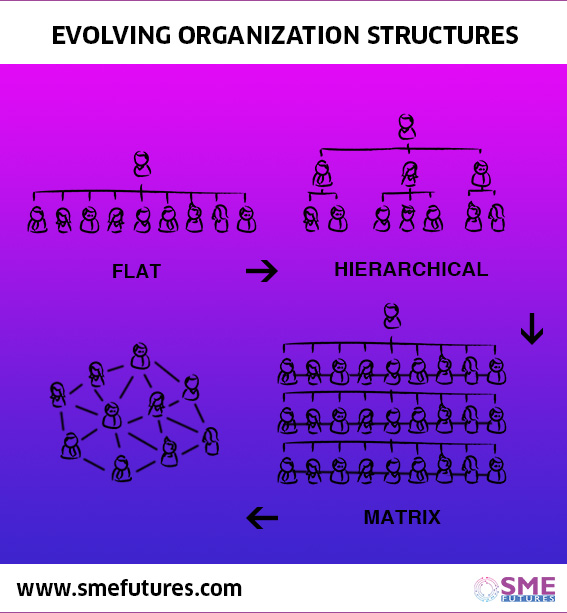The organisations must keep on reviewing their needs of implementing HR processes required for effective functioning and delivering desired results. The dilemma of viewing HR processes as an investment or a cost needs to be addressed prudently
Also read https://smefutures.com/commentary/hr-investment-cost
The first HR priority for a start-up trying to scale up or an SME, to enhance effectiveness of internal functioning, will be to ensure an optimal organisation design. This is an initiative which tends to get missed out by most organisations, and alternatively gets addressed in unstructured manner, which leads to major avoidable inefficiencies and fall-outs. As such “Organisation design” largely involves creation of role descriptions, reporting relationships, chain of command and management processes which directly impact effective functioning of employees, in turn leading to ability of the organisation to achieve its strategic objectives. Various studies have shown that a structured approach to organisation design helps to reduce costs, drive growth, and strengthen both short-term performance and long-term organisational health.
One of the key aspects of organisation design is Organisation Structure. As one can visualize, there is no single structure which right fit for all organisations would be. Every organisation has to adopt different structure, which is a function of various factors namely, life cycle stage of the organisation, business model, industry, talent landscape, size, leadership styles and culture. Primarily structures were traditionally made around functions or business divisions. With increasing complexities and inter-dependencies, these have further evolved into matrix structure (a combination of function and division) and further into network structure, which involves multiple relationships of managers.
Initially all start-ups start with a very Flat structure, where promoter entrepreneur hires people to carry out multiple jobs, who directly report to him. This is most effective structure at this stage of organisation life cycle, as it ensures speed as well as optimization of cost, which is very important at this stage. It is therefore advisable that SMEs should operate with a flat structure in initial growth phase and just add people strictly based on increasing activities/ volumes without creating any hierarchies.
As an organisation grows and keep adding more people, it becomes difficult beyond a point that promoters can handle everything themselves. In fact, the initial strength of flat structure helping in quick decision making, now make things slow-down, as every decision needs to be directed to same few people, who end up becoming a bottleneck due to limited bandwidth.
Boston-based Wistia found as they grew, a flat structure started turning from boon to bane. Their CEO, Chris Savage, reflected in a blog post: “As our company grew from 2 to 30 people, I was surprised to see how the strengths of a flat organisation turned into our team’s biggest weaknesses”.
In such growing organisations eventually, any leader will be overwhelmed, without introducing much dreaded hierarchy. While the general best practice is to have 8 to 12 reportees, in some cases, leaders have tried to have as many as 40-50 people all reporting up to a single person. With no structure, the quantity of problems as well as quality of decision making become major issues. How do you address all the problems that come up when there are too many people coming to you? They either get ignored, or you never get enough of the right things done.
This is the time when growing start-ups or small SMEs should put formal hierarchical structure in place. At this stage, organisation need to deliberately introduce hierarchy by meaningful clubbing activities and identifying team leaders to handle a set of people. Simultaneously, it will require clearly articulating roles, responsibilities and defining accountability, along with Delegation of authority.
This transition is normally difficult as it requires letting go of “flat” management style, and allowing people to make their own decisions, which normally is quite scary. In fact, for founder of a start-up, it’s often very unsettling, because he always has a fear of people making mistakes. But the fact is that people will make some mistakes, which entrepreneur also might have made in his initial phase. But for developing leaders those risks have to be taken and costs involved if any, have to be borne. As promoters start this transition, sometimes they get perturbed by some challenges which they face in terms of certain wrong decisions made, some delays and increased costs. But these are natural challenges likely to come in this transition process and need to be managed prudently, rather than turning back.
Interestingly, Google faced a similar situation, when their founders Larry Page and Sergey Brin wondered whether they need any Managers at all. As reported in HBR, Google founders learned this lesson the hard way —
‘In 2002 they experimented with a completely flat organisation, eliminating engineering managers in an effort to break down barriers to rapid idea development and to replicate the collegian environment they’d enjoyed in graduate school. That experiment lasted only a few months: They relented when too many people went directly to Page with questions about expense reports, interpersonal conflicts, and other nitty-gritty issues. And as the company grew, the founders soon realised that managers contributed in many other, important ways—for instance, by communicating strategy, helping employees prioritize projects, facilitating collaboration, supporting career development, and ensuring that processes and systems aligned with company goals.’
Moving from flat structure to hierarchical structure is a natural progression of any growing organisation. As organisations grow more, a normal hierarchy starts posing problems in effective coordination and functioning, where business unit and functional structure is needed to be introduced. With increasing size and complexity, matrix structure and network structure become need of the hour. A periodic review in view of internal and external changes, with help of an expert, is necessary to avoid any major fall-outs.
Structures will only help organizing people involved in delivering a business objective in a particular manner. In addition to the organisation design itself, success or failure of the structure is also dependent on the people sitting in different boxes. It is therefore critical to involve them in designing/ changing any structure, so that there is a better understanding and alignment. Otherwise it may be viewed as an attempt to put them in confined space and may lead to introduction of bureaucracy, which will make it dysfunctional.

Structure must be designed keeping business needs, roles and responsibility in mind and not around specific employees/ leaders. Any structure which is created to accommodate a leader, becomes dysfunctional sooner than later. Other aspects like span of control, number of layers, delegation of authority and accountability are also very critical, for making effective implementation of organisation design.
It is important to remember that organisation structures cannot be kept static. While structures are not to be changed every now and then, but they need to be reviewed periodically, in view of business growth, diversification, introduction of new specializations, market changes and customer expectations. In case organisations fail to notice the need of change in structure at right time – say, from geographical focus to product focus, or elimination of a dysfunctional layer, or introduction of matrix reporting where needed – it may lead to significant negative impact on business results, major opportunity loss and huge costs. At the same time, appropriate adjustments in organisation design in line with internal and external environment changes, leads to visibly positive business outcomes.
Note to Readers: The content of this article should not be copied/ reproduced in any form, as its copyright is solely owned by the Author and Polygon Media Pvt Ltd.











